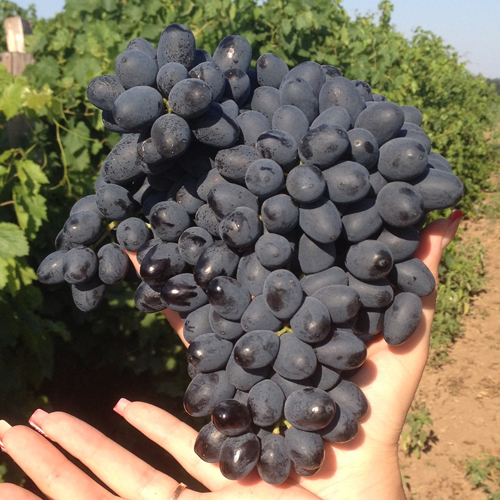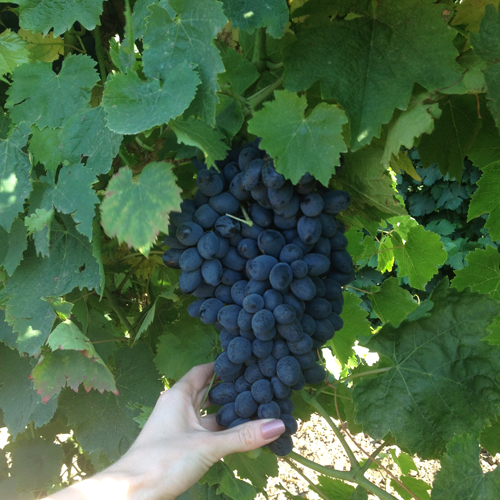Attica grape variety
Attica is a dark colored seedless grape native to Greece. It was obtained as a result of hybridization carried out in 1979 by V. Michos (Vassilios Michos) at the Athens Institute of Viticulture. The old and very well-known varieties of Alphonse Lavalle and Black Kishmish were used for crossing. Over the years since its inception, our hero has become very popular both in his homeland and in many other European states. In a number of them, it was even officially included in the catalogs of varieties admitted for industrial cultivation.
The variety belongs to the purebred representatives of the noble European-Asian species Vitis vinifera. This largely determines its advantages and disadvantages. The first can definitely be attributed to the excellent indicators of large-fruited, yield, attractiveness of the appearance of the bunches, as well as the sophistication of the taste of berries. The negative features of grapes are low frost resistance and resistance to fungal diseases, which generally determine some of the effeminacy of Attica and the need for careful care of it.

The variety is not very common among domestic winegrowers, but those amateurs who cultivate it share only positive emotions about the aesthetic and gastronomic qualities of the Greek guest.
Agrobiological characteristics
The vigor of the grape bushes is above average. The crown of a young shoot is closed, whitish from intense pubescence. The shoot axis is green, without anthocyanin veins. The leaves are large, rounded, or somewhat stretched in width, three- and five-lobed, moderately dissected. The surface of the leaf blade is dark green, finely bubbly, the profile is wavy. Top side cutouts of medium depth, open slit or V-shaped. The lower notches are small, barely marked or absent. The petiolate notch is usually open - vaulted or lyre-shaped. The petioles are long, graceful, green, often mixed with reddish tones. The teeth along the edge of the Attica leaf are not too large, of various shapes: partly triangular, partly domed. The flowers are bisexual and show good pollination with their own pollen every year. The inflorescences do not crumble, and the berries do not show a predisposition to peas. The maturation of the one-year growth proceeds well and for a considerable length.
Bunches of grapes grow very large, up to 30 cm long and with an average weight of 600-900 grams. Many weigh more than a kilogram. The ripe brushes of this variety are quite dense in structure, conical or cylindro-conical in shape. Grapes within a bunch may differ slightly in size, which, however, does not have a significant negative effect on the presentation. As a rule, berries are not damaged or deformed against each other, despite the relatively high density of the brushes. The grapes themselves have an oval or oblong shape, reach about 25 mm in length, and 19-20 mm in diameter, are painted in a dark blue or purple color with an intense bluish waxy bloom on the surface. The weight of 100 berries ranges from 400-500 grams. The pulp is dense, oriental crisp, has a pleasant balanced taste, but does not differ in a bright varietal aroma. The sugar content of the berry juice is 16-18 g / 100 cubic meters. cm, and the titratable acidity does not exceed 5g / cubic dm. The skins of the berries may seem quite thick, but they chew well when eaten and do not have a repulsive astringent taste. The fruits lack full-fledged bones, instead of which, upon careful search, one can find small underdeveloped rudiments. They are felt during tasting only in the largest grapes. Due to its seedlessness, the taste characteristics of Attica are always highly rated.

The harvest is mainly used for fresh consumption and high quality dried fruits. Seedless grape varieties have traditionally attracted increased interest from consumers, due to which prices for them are significantly higher than for conventional table varieties. In the case of our heroine, an additional and important advantage is the early ripening of the bunches, when on the market during the day with fire you will not find even fruits that are close to her in quality. In this regard, it enjoys the attention of farmers, who value it for its high income per unit area. It is impossible not to mention the excellent transportability of the collected bunches, which, even when moving long distances, do not reduce their visual appeal. The grapes are also stored well, without decaying and without reducing their weight. The main thing is to ensure the optimal conditions in the room in terms of temperature and humidity. In southern European countries, good raisins are produced from Attica, and domestic amateurs successfully process surplus rich harvests into compotes, preserves and jams, which are wonderful both in color and taste.
The early maturing variety is considered to be due to the short growing season that plants need to ripen the crop. So, from the moment the buds bloom in the spring, no more than 115-120 days pass until the bunches reach full ripeness. In the south of our country, harvesting can begin in the second decade of August. During this time, the sum of accumulated active temperatures reaches 2400-2500 ° C, which theoretically indicates the possibility of cultivating this grape in non-traditional for viticulture, relatively northern regions, but in practice, for this, it will be necessary to provide a very reliable shelter for the winter, since the frost resistance of the variety does not exceed -18 ° C. In domestic conditions, without insulation, it can be grown only in the subtropical climate of the Black Sea coast.
The productivity of Attica can only be described in enthusiastic terms. Due to the large-fruited and high fruitfulness of the shoots that have developed from overwintered eyes, 25-30 tons of grapes are obtained per hectare of plantations. In household plots, from each adult, well-developed bush, you can get up to 18-20 kg of bunches. However, plants often show a dangerous tendency to overload. Abuse of their generosity, as well as ignoring the need to standardize yields, threatens with a decrease in the growth force and ripeness of shoots, an extension of the growing season and a sharp deterioration in the quality of the fruits obtained.
Despite the early maturity of our heroine, there is no need to rush to harvest her crop. The variety is characterized by a rare feature - its berries color quite quickly, soften and lose acidity, but sugar still continues to accumulate. The impatience of the grower can lead to the fact that the bunches are not harvested sufficiently ripe, and as a result it will be impossible to properly appreciate their gastronomic splendor. It is better to overexpose than underexpose the crop on the vine, especially since it can hang ripe for a long period of time without losing its taste and presentation. Thanks to the thick skin, it is not afraid of wasps and hornets, and the berries crack only in the most unfavorable weather, for example, with a sharp change in soil moisture or prolonged rains.
Agrotechnical features
Like most other varieties of grapes of the purebred European-Asian type, Attica does not have sufficient resistance to adverse environmental factors, which means it needs very careful care of itself.This is especially important for domestic winegrowers to take into account, since the climatic conditions in most regions of our country are incomparably more severe than in the homeland of the variety - in the south of the Balkan Peninsula.
For good development of young plants and subsequent abundant fruiting, the planted bushes must be sufficiently provided with heat, moisture and sunlight. Particular attention should be paid to the terrain. Lowlands and gullies, where cold air constantly accumulates, the slopes of northern expositions, damp and swampy soils, as well as areas with a level of groundwater occurrence close to the surface, are absolutely not suitable for the vineyard. On the plains, a great advantage will be the creation of dense windbreak strips that protect the plantings from the northern winds, and in the conditions of the personal plot, the same effect can be achieved by planting grapes in the so-called "wall" culture on the sunny side of various buildings and capital fences. The optimum soil pH is between 6.5 and 7.2. The soil must be well structured to ensure high water and air permeability.
The variety is propagated mainly by grafted seedlings, since it does not possess resistance to root phylloxera. It shows good affinity with most of the known rootstock forms, but it is recommended to use vigorous varieties that better meet the needs of the highly productive Attica. Recommended planting pattern: 2.5-2.7 meters between rows, and 1.6-1.8 meters between plants in a row. For other options, the supply area must be maintained at a level of 4-4.5 square meters.
With good quality grape seedlings, proper preparation of the soil for planting and regular watering, young plants begin to bear fruit in the third year. In our country, the variety is almost universally cultivated in a covering culture, for which, from the first years of life, they begin to form bushes according to squat, standard-less patterns - in the form of a multi-arm fan or an inclined cordon. Warming of the vines removed from the trellis in the fall should be carried out with great care in order to prevent both freezing and damping of the wintering eyes.
One of the most important activities in a fruiting vineyard is the rationing of bushes by shoots and harvest, which is divided into three stages. Initially, during spring pruning, 30-35 buds are left on the plant, depending on the specific conditions. Due to the good fertility of the lower eyes, the fruit arrows can be shortened quite strongly. Then, after the beginning of the growing season, a fragment of weak and sterile shoots is produced. At the final stage, the number of inflorescences is thinned, leaving only one per shoot. Only then can the load be considered adjusted.
Fighting fungal diseases is another prerequisite for a good harvest. The resistance of Attica to them is at a weak level, and therefore the grower will have to carry out complex plant protection according to the schemes traditional for susceptible varieties. At the same time, the number of treatments of grapes with fungicides can reach 6-8 per season.








